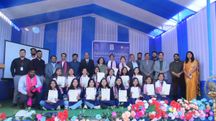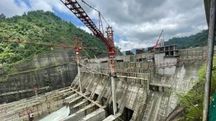Assam, Manipur most improved state for the year 2022: India Today Survey
The states were ranked indicating improvement in the past 5 years based on positive changes (outcome-based).
 Assam, Manipur most improved state for the year 2022
Assam, Manipur most improved state for the year 2022Two Northeastern states of India, Assam and Manipur have bagged the most improved state award according to the latest India Today Survey.
Assam made it to the top position in the most improved big states category while Manipur secured the top position in the most improved small states category.
The states were ranked indicating improvement in the past 5 years based on positive changes (outcome-based).
The states were also divided into two broad groups—big states and small states— which is again based on geographical area and population. Deliberations revealed that bigger states have their own advantages and disadvantages vis-à-vis the smaller states.
States with an area of over 35,000 sq. km and a population of over 5 million were clubbed as the big states and the rest as small, however, Jammu & Kashmir was not considered due to the change in its status.
Twelve categories such as Economy, Infrastructure, Agriculture, Health, Education, Law and Order, Governance, Inclusive development, Entrepreneurship, Tourism, Environment and Cleanliness were identified for comparing the performance of the states.
Notably, over the past couple of years, the state of Assam has made the maximum development in the field of infrastructure, agriculture, education, law and order, inclusive development, tourism and environment while, Manipur has improved in eight out of twelve categories including economy, infrastructure, agriculture, health, governance, entrepreneurship, and cleanliness wherein Health, Governance and Tourism were the three categories where Manipur has improved in the last 5 years.
This is for the third time that Manipur has emerged as the country’s most improved small state. This year, Manipur with 1219.5 points out of 2000 outperformed Mizoram who stood at 1147.6 out of 2000 points. This is for the third time that Manipur has emerged as the country’s most improved small state.
Manipur Chief Minister N Biren Singh credits this to the period of peace in the past four years, free of frequent terror attacks, ethnic conflicts or economic blockades and said that his past experience as a journalist and a footballer has helped him to attain the feat.
Speaking on the growth of Assam, the state has achieved a growth that is higher than the national average for 7 years now.
In the survey, Assam stood tall in the most improved big states overall scoring 1185.3 out of 2000 while Andhra Pradesh and Madhya Pradesh followed Assam in 2nd and 3rd position respectively.” In 2021, Assam was ranked second, however, in the years from 2018 to 2020 it dominated the top rank.
"When Prime Minister Modi has been working round the clock for the progress of the country, it’s our responsibility to do what is in our limited capacity to strengthen his hand.” We have a long road to cover.", said Assam Chief Minister Himanta Biswa Sarma while speaking to India Today Group.
How the states were ranked ?
The India Today State of the States 2022 study was conducted by Marketing and Development Research Associates (MDRA), a premier Delhi-based research agency. The
robust methodology is designed to rank the states on the basis of the most relevant and exhaustive data, covering aspects that are crucial in fostering inter-state competition
and upholding the true spirit of India’s federal structure. The states were ranked under two broad groups -- Best performing states and Most improved states.
Best-performing states indicate the latest performance of the state specific to the category and are based on the most recent data across multiple parameters.
On the other hand, most improved states indicate improvement of the state in the past five years and based on positive changes (outcome-based) in the past five years.
The states were also divided into two broad groups—big states and small states—based on geographical area and population. Deliberations revealed that bigger states have their own advantages and disadvantages vis-à-vis the smaller states. States with an area of over 35,000 sq. km and a population of over 5 million were clubbed as the big states and the rest as small. Jammu & Kashmir was not considered due to the change in its status. Twelve categories were identified for comparing the performance of the states.
In each category, several parameters on which the states needed to be competitive were fixed. Based on inputs from experts—academia, policymakers, and policy influencers such as representatives from the NITI Aayog, think tanks, policy research organizations, sociologists, and economists—125 parameters were finalized for evaluating the best-performing states and 89 for the most-improved states. The relative weights of the parameters were finalized in consultation with the experts, India today editors, and the MDRA team.
Based on the parameters and attributes, a comprehensive data collection exercise was undertaken. MDRA researchers cross-examined the data collected from highly credible sources such as the Census, Reserve Bank of India, NITI Aayog, respective ministries and departments, and state governments. To ensure a fair comparison, it was ensured that no state got an unfair advantage on account of size, population, or any other aspect.
It was necessary therefore to normalize the data based on population or geographical size, as required. The data collected for each attribute was cleaned, normalized, and standardized to make it comparable. The most recent data for each state (mostly 2021-2022, 2020-21, 2019-20, 2018-19, and 2017-18) was taken and analyzed to evaluate the best-performing states. To compare and rank the most improved states, compounded annual growth rates (CAGR) on each attribute for the past five years were used.
Based on the weights determined for each attribute, sectoral rankings were arrived at. Parameter-level weights were used to determine the overall best-performing and most improved states.
A large MDRA team, led by Abhishek Agrawal (executive director), Abnish Jha (project director), Vaibhav Gupta (assistant research manager), Aditya Srivastava (assistant research executive), and Manveer Singh (senior executive-EDP) and assisted by statisticians and econometricians, worked on this voluminous project from July to November 2022.
Copyright©2025 Living Media India Limited. For reprint rights: Syndications Today









